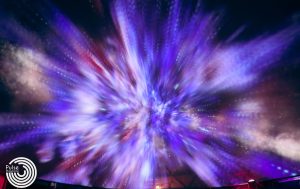Take a Roll with Printmaking
Photos by: America Salazar
In the world, there are a thousand types of mediums that an artist uses. Whether they mix them or use one medium, there are artists who spend their lifetime creating a perfect piece of art. To some, art is just a stress reliever. To others, art is their life. For these two printmaking professors in the UTRGV Brownsville campus, art is their life and the reason why they are in love with printmaking and goes to teach the students at UTRGV about the wonders of printmaking as a medium. Meet Noel Palmenez (left) and Jessie Burciaga, both part-time lecturers in UTRGV’s School of Art and Design who are artists and teachers.
Q1: What was the moment you realized you had fallen in love with printmaking?
Jessie Burciaga: It was because it was hard. It gave me a challenge. For me, the reason I fell in love with printmaking is because of the community. Having a press is expensive, but if you reach out to other artists or go to the studio here in UTRGV, they are more than willing to help you. Printmakers here, when they make something new, they are always eager to show someone else how they did it.
Noel Palmenez: I can appreciate it because of its versatility. A lot of time you put in a lot. And to drawing, which is, I think drawing is the foundation to painting or graphic design. It is anything 2-dimensional, you know, drawing. It is the foundation of that. Sometimes you are not willing to take many chances because you’re like halfway in or take another way in, and sometimes you are afraid of experimenting.
Q2: What would you have to say to anyone considering making an artwork from linocut or wood block?
Jessie Burciaga: It is a giant stamp. The simplest way to show that. It is a giant stamp that you get to carve the design out of. It is more like you must have patience. It is a very tedious process of getting a design done and carved out of the lino block, but it can get done. You are not going to see the end results until you get it printed.
Noel Palmenez: Start getting an idea of the idea first. Linocut is a lot about contrast in the sense of what your darks, what your light is. The idea is to kind of figure out the areas you would like to form an image. You could try to get the image of pop a little bit more so as far as the composition. Then start figuring out what kind of line you would like to use. You know. Everyone, of course, starts off with a contour line to describe the image. But then, of course, you have all kinds of textures. You have lights, shadows, and shade, and then use various kinds of lines to interpret that.
Q3: What piece have you made that took you the longest time to complete and how many hours did it take to complete it?
Jessie Burciaga: I’m going to give one of my artworks, “Donde de Corazón,” as an example. It took me about three months to finish well. It took a long time to dry. Monotypes did it all on tracing paper, so I would only make two or three a day because the process took long.
Noel Palmenez: I really would not know. I never count the hours. They just seem to take over sometimes, you know, depending on the work. But sometimes I invest a lot of time, and in the end, I am not completely happy. But there are some aspects of it that I do like. It’s more of a tedious kind because I look at everything, you know. I have a habit of touching everything to a point where it consumes all hours, you know, from the design effort, but that has always been. There are times when a piece takes up to 50 or 75 hours (about three days) to complete. You must devote time and dedication to your pieces.
Q4: What frustrates you the most as an artist?
Jessie Burciaga: As an artist, it is frustrating to not have a big, good space to do your work in, especially when it comes to having a studio or somewhere big to do your artwork comfortably. I like to work in large workstations. When moments become frustrating, like finding a good space to work in, I go ahead and find the place where I want to work. I would go look to work outside where the space is big and breathable working spaces based on my past experiences.
Noel Palmenez: I do not think I could do art all the time. You know, because it takes a lot of energy. It takes a lot of effort and dedication because if you make art when your energy is not completely there, it will show in your artwork and come off as messy and lazy . Another thing that I would consider to be frustrating is that it requires a lot of time and because I am a husband and a father as well as a teacher. There are times when you cannot take all the time to dedicate your work and that is something you need when creating a piece. There are times when you want alone time to create something with your hands.
Q5: What artist would you say has inspired you the most and why do you love it?
Jessie Burciaga: Doris Santiago is an artist that works with installations. Her pieces are different and exquisite to the eye. It is different from what I have seen and inspired me to do installations.
Noel Palmenez: All my professors have inspired me, regardless of whether I appreciate the challenging work or not. Those are the ones. You know that it really inspired me because I got to meet them and work with them. That is most. I like my works by Francisco Boy or William Blake. They have a lot of value to them to the more traditional works. Those have always been the most valuable, because you know, I was able to communicate with them. I have been able to pick their brains and the ways that they have worked.
Q6: What kind of emotions do you feel when you are teaching in a classroom?
Jessie Burciaga: It’s funny because I teach the basic printmaking classes and it is making a lot of students unsure of knowing what to do. I’ve done it before, but others don’t always get it on the first try. I think positively because it’s an open world. The students are open to learning, they keep their eyes open and are ready to meet. Their mind is still there without any outside influence on me, so that’s something that I enjoy doing. They have never seen it before. And when you think of your first demo, and they seem okay, there is a branch, like wow, that happened.
Noel Palmenez: I try to feel excitement. Try to feel motivated. Try to feel ambitious, or try to feel, you know, as I would like to see this to behave. I try to be. You know, that type of, you know, momentum. And you are saying it is positive, you know, not being negative. You just try to deliver every day, you know, regardless of whether you feel like the students are listening or not. You know it could be one or two that will be immensely helpful to you for some that are doing fine on their own.
Q7: What would be a message you would want to give to your younger self, who was trying to start out as an artist?
Jessie Burciaga: Believe in yourself. Do not hyperfixate on one thing. Always try out different mediums. If you do not try different things, you may never expand your horizons and it will be difficult later on if you have not at least tried something new.
Noel Palmenez: Be passionate. You know, your career. And just hold it just to stay in it, you know. Just try and say the game is as productive as you can keep your perspective, you know, completely wide open. Do not be shy. You must be aggressive, but it also depends on what success you are looking for. You know everyone has the potential to change. You know what they do. So, do you have more of a narrative artist or more abstract and conceptual? Or are you more realist, or realist, or abstract, or are there so many unique ways of approaching it? You also must be open to receiving criticism, it can be hard to listen to, but you must have an open ear to criticism.
Q7: What is your favorite medium to use as an artist?
Jessie Burciaga: I would have to say that I do not have a specific favorite medium of mind that I particularly use, but my favorite would be printmaking. I like to experiment and use different mediums with it to create a new print. I enjoy the experiential part of the medium.
Noel Palmenez: One of my favorite mediums would be graphite just because it is very minimal. It is just black and white and like the challenge of transforming something, you know, from a flat blank sheet of paper to something. Taking something that again there is nothing there just worth a single stick of graphite, a pencil. But again, as far as printmaking, I really like to process a lot. It takes a lot of work. It’s not always, of course, exactly what you want, but I would rather have it like that. I am not one that likes to stage everything, and we edit everything or use the computer perfectly. I am okay with it being a little bit of here in there because that is what makes it more authentic.
The lecturers have inspired and educated students over the years about the exciting world of printmaking. Students enter the room and will say that printmaking looks challenging and that they should refrain from trying to carve a piece. Still, Palmenez and Burciaga to demonstrate to the students who enroll each semester that it may seem complicated, but they will learn with dedication and patience. Their work will look great and they will have a sense of accomplishment. Being an artist is difficult due to the struggle. It would be best to strive to move out of the comfort zone periodically; otherwise, the artist may need guidance on how to proceed. That is why both Palmenez and Burciaga said they love to teach about the wondrous world of printmaking and the obstacles that lie in the way.





